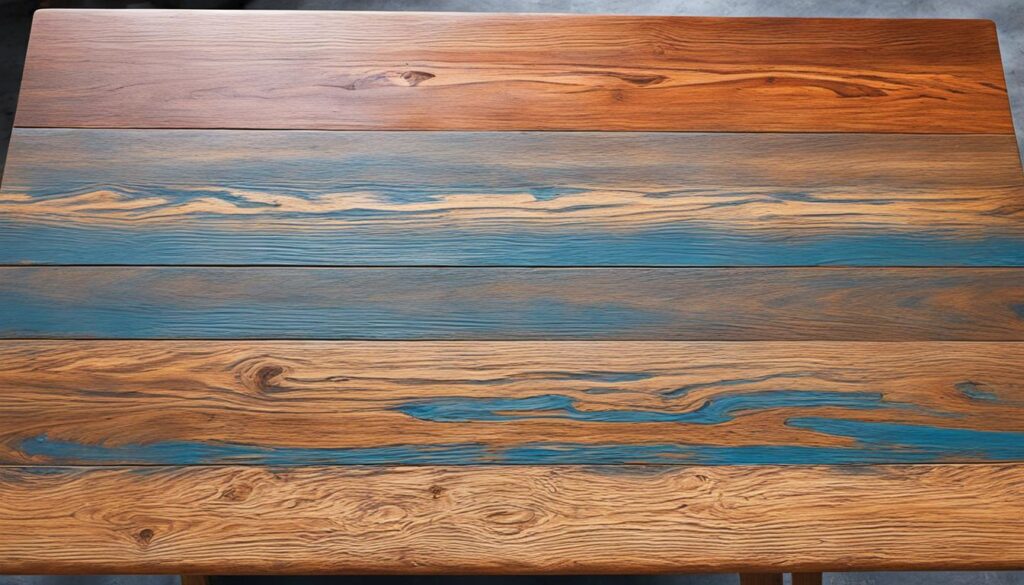Danish oil typically requires an initial drying period of 4 to 6 hours, with full curing achieved between 72 to 120 hours. Drying time is influenced by factors such as temperature, humidity, wood species, and application techniques. Proper preparation involves sanding to 220 grit, applying the oil with a lint-free cloth, and allowing each coat to dry for at least 24 hours. Regular maintenance is necessary to maintain its finish. By ensuring ideal conditions and following recommended procedures, you can achieve a durable and aesthetically pleasing finish. For more in-depth insights, continue exploring this topic.
What is Danish Oil and How Does it Work?
Danish oil, a versatile wood finishing product, is composed of a blend of tung oil or polymerized linseed oil, varnish or resin, mineral spirits, and drying agents, which work together to enhance and protect wood surfaces.
The danish oil composition allows the product to deeply penetrate the wood, rather than merely coating the surface. This penetration is facilitated by the solvents in the mixture, which carry the oil and resin components into the wood pores.
The danish oil function is to provide a hard-wearing, water-resistant finish that enhances the natural wood grain and wood texture. As the solvents evaporate, the drying oils begin to polymerize and harden, interlocking with the wood fibers.
The varnish or resin components also cure, contributing to the overall durability and satin sheen of the finish.
One of the key advantages of danish oil is its ability to offer long-lasting protection without cracking or peeling. The danish oil drying process involves an initial drying period of 8-12 hours, followed by a curing time of 3-5 days for the oil to fully harden.
Multiple coats can be applied to achieve a smoother finish and enhanced water-resistant finish, ensuring the natural beauty and integrity of the wood are preserved.
How Long Does Danish Oil Take to Dry?
Understanding the time required for Danish oil to dry is fundamental to achieving a durable and aesthetically pleasing finish on wood surfaces. Danish oil drying time is influenced by several factors, including application techniques and environmental conditions. Typically, Danish oil becomes touch dry within 8-12 hours, but it requires a longer curing time of 3-5 days to fully harden within the wood pores.
The drying time for Danish oil can vary based on several factors:
- Temperature and Humidity: Cooler temperatures and high humidity can greatly extend the drying duration.
- Wood Species: Different woods absorb oil at varying rates, affecting drying and curing times.
- Number of Coats: Additional coats will increase the overall drying duration.
- Application Technique: Properly wiping the surface dry after 15-30 minutes of application can prevent prolonged drying.
During the initial drying period of 4-6 hours, the oil penetrates the wood pores. After this period, the surface should not feel tacky or sticky. However, for a complete Danish oil finish, the curing time for Danish oil extends to 72-120 hours. This curing period is essential for the oil to harden fully, ensuring maximum protection and durability.
Adhering to the recommended drying time for Danish oil is essential for achieving the desired final result.
Proper Application of Danish Oil for Optimal Drying
Proper application of Danish oil, essential for achieving ideal drying and curing, begins with meticulous surface preparation and strategic application techniques. The wood must be sanded smooth, typically up to 220 grit, and thoroughly cleaned to remove any dust or debris. Ensuring the wood is dry before applying Danish oil is essential for best absorption and drying.
When applying Danish oil on wood, use a lint-free cloth, brush, or pad to apply a liberal coat along the wood grain. It is important to keep the surface wet for 10-20 minutes, reapplying oil to any dry spots. After this period, thoroughly wipe off any excess oil to avoid prolonged drying times and potential tackiness. This initial coat should be allowed to dry for at least 24 hours to facilitate proper curing within the wood pores.
Subsequent coats should follow the same application process, with light sanding between coats using 320-400 grit sandpaper to smooth raised grain. Final drying time should be at least 72 hours, although some brands recommend up to 7 days for complete curing.
Adequate ventilation and warm temperatures act as natural Danish oil drying accelerators, ensuring a durable and high-quality finish.
Maintaining and Refreshing a Danish Oil Finish
Maintaining and rejuvenating a Danish oil finish requires meticulous attention to regular cleaning and periodic reapplication to preserve the wood’s aesthetic and protective qualities. Proper danish oil maintenance guarantees a long-lasting, rich, and low-luster finish.
Routine cleaning is essential to maintain the finish. For daily maintenance, use a damp cloth with water to wipe down the surface. For deeper cleaning, employ a mild soap and water solution, ensuring thorough rinsing and drying.
Over time, revitalizing the wood finish with Danish oil becomes necessary. When the finish appears dull or dried out, follow these steps:
- Lightly sand the surface with 220-320 grit sandpaper or a Scotch-Brite pad and remove any dust.
- Apply a thin coat of Danish oil with a lint-free cloth, allowing it to penetrate for 15-20 minutes.
- Wipe off excess oil and permit a 24-hour drying period.
- For high-use surfaces, consider applying 2-3 thin coats, sanding lightly between applications.
Danish oil finish frequency varies with use but generally requires rejuvenating every 6-12 months. Adhering to proper danish oil maintenance and following these danish oil finish tips will ensure the wood remains protected and visually appealing. Allow sufficient danish oil finish drying time between coats to achieve optimal results.
Danish Oil vs. Other Wood Finishes
While preserving a Danish oil finish promotes its longevity, comparing it to other wood finishes like polyurethane, lacquer, and tung oil reveals distinct advantages and limitations that impact the choice of finish for different woodworking projects.
Danish oil, a blend of natural oils and resins, penetrates deeply into the wood, enhancing the grain and providing a warm, satin finish. This makes it an excellent choice for furniture and other woodworking projects where a natural look is desired. The typical Danish oil drying period is 8-12 hours, with a complete cure taking 3-5 days.
In contrast, polyurethane forms a durable, protective film on the wood surface. Available in both oil-based and water-based variants, it offers superior resistance to moisture, scratches, and chemicals, though it can appear somewhat artificial compared to Danish oil. Lacquer, known for its fast-drying properties and high-build finish, is ideal for cabinetry and furniture but requires good ventilation due to strong fumes.
Danish oil application tips emphasize wiping off excess oil after 15-30 minutes to prevent prolonged drying. Despite requiring regular maintenance, Danish oil projects benefit from its ease of application and ability to enhance the natural beauty of wood. Understanding these differences allows for informed decisions in selecting the appropriate wood finish.
Welcome to WoodCraftYard.com, your one-stop destination for all things woodworking! I’m Oliver Candler, a dedicated woodworking aficionado and the creative mind behind this virtual woodworking haven. With a deep-rooted love for craftsmanship and a keen eye for detail, I am on a mission to share my passion for woodworking with fellow enthusiasts like yourself.
As a seasoned woodworker, I am committed to providing you with valuable insights, practical tips, and inspiring project ideas to help you unleash your creativity and master the art of woodworking. Whether you’re a seasoned pro or just starting out on your woodworking journey, join me as we carve, sand, and saw our way through the world of woodworking together.
Let’s embark on this woodworking adventure, where every knot, grain, and finish tells a unique story. Together, let’s craft, create, and build something truly extraordinary at WoodCraftYard.com!



